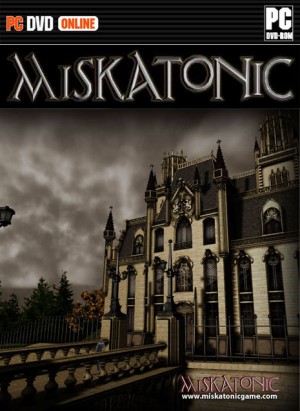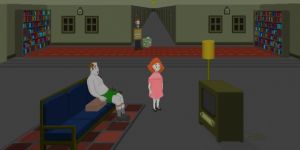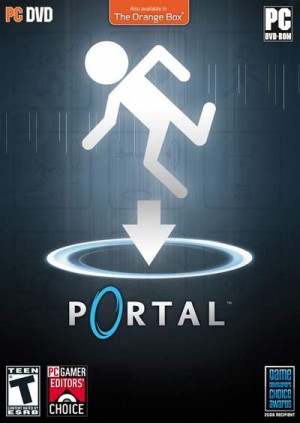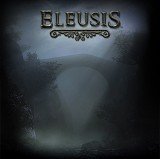Review for Miskatonic: Part 1 - The Inhuman Stain
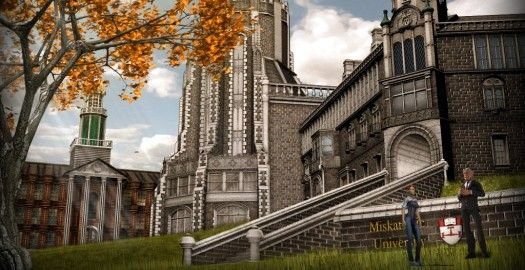
When it comes to horror, few writers have been more influential than H.P. Lovecraft. Whether it’s tentacle-laden monsters from beyond the stars or small towns where everyone turns out to be part of a deadly cult, there are several plot elements now considered classic (or even cliché) that can all be directly traced back to his stories written almost a hundred years ago. Miskatonic, from indie developer jackslawed, is a fairly straightforward homage to the writer that makes no secret of its Lovecraftian influence. Where it diverges from its inspiration is in trying to combine the creeping horror of his works with an occasional sprinkling of humor, which isn’t a bad idea in principle but doesn’t always strike the right tone in the game. The debut episode in a planned three-part series is a decent first effort in several ways, but the limited production values and minimal plot development so far combine to create some notable rough edges that the rest of the game just isn’t able to smooth over.
In Part 1 – The Inhuman Stain, you play Aurinda Hearn, a newly-hired faculty member at Miskatonic University. After arriving at the venerable old campus, it doesn’t take long for mental alarm bells to go off. The dean warns Aurinda to stay out of the woods, refusing to specify why, and the entire Engineering department has recently vanished in a mysterious offshore accident (save one remaining teacher). When Aurinda enters her office for the first time and finds it ransacked, she becomes determined to get to the bottom of things, a course of action that multiple friendly colleagues warn is likely to get her killed. These warnings don’t stop her from attempting to infiltrate the conveniently neighboring insane asylum, however, in order to wrest answers from the last person to hold her position who is now interred there.
Miskatonic uses a fairly intuitive and familiar interface. Each screen has a variety of hotspots, some of which can be left-clicked either to get a closer look or to exit the screen. Others make the cursor turn red, indicating that right-clicking will bring up a overly-animated menu option to manipulate, examine, or speak to the object or person in question. Inventory is stored in a bar at the top of the screen, and using an item is as simple as clicking on it, then clicking again on whatever you wish Aurinda to attempt to use the object on, whether a hotspot in the environment or another item in inventory. Aurinda walks fairly slowly, but double-clicking exits automatically shifts to the next scene, and a map is automatically filled in as you discover new areas, allowing for instant travel between them after that.
As simple as the interface is, it doesn’t make it any easier to solve puzzles, several of which are downright baffling. One requires placing a variety of colored globes on a machine, each representing a specific planet that needs to be placed in a very particular spot. Once I’d placed all the ones I possessed, I realized I was still missing one. After fruitlessly searching for it, I gave up and peeked at a hint on the internet. My embarrassment at being unable to solve the puzzle quickly turned to annoyance when I discovered the actual answer to my dilemma, as not even the vaguest clue for reaching that solution was ever offered. Or if it was, it was certainly easy to miss. There are other examples of a similar lack of feedback or logic, but I don’t wish to spoil any details for those who like to be bewildered.
That’s not to say the game is nothing but obscure puzzles with seemingly random solutions, as there are a couple of very nicely crafted ones as well. Figuring out a passcode based on emails, notes, and bulletin board memos is a fun challenge, as is gathering the materials needed to distract a crazy inmate in the Miskatonic Sanitarium. But even these obstacles are made significantly more difficult by the frequent need to pixel hunt. There was one building I didn’t think I could enter at all, simply because I wasn’t holding the cursor over the exact spot needed to open the door. Such instances happen throughout much of the game, and either a hotspot finder or clearer visual representations of relevant objects would have helped greatly.
The graphics themselves are a little lackluster all the way through. All characters have simple and rather cheap-looking facial designs, while Aurinda moves somewhat stiffly and her figure almost seems to glide rather than step across the screen. The quality of the background components differs greatly, giving the game an uneven appearance. The intricate stonework of a bridge is quite detailed, for example, but the grass looks like a two-dimensional plane of green and brown splotches, and trees look like they’ve been cut and pasted on top of them. The overall design of the campus itself is nicely presented, featuring a courtyard decorated with a huge pentagram and an ornate obelisk. These elements give Miskatonic University an almost gothic and often dark ambiance, fitting the theme perfectly, but the graphics are hindered by a lack of visual crispness. There are a few nice touches like autumn leaves falling in forest areas that give the presentation some life and flair, but the highlights are few and far between. As a largely one-man creation, Miskatonic is understandably a low budget game, but that doesn’t excuse disappointing design choices like giving in-game journals such small print that you practically have to squint to read them. And so many of the locations are simply pathways in between important places that it’s a shame the effort wasn’t focused more on quality rather than quantity.
The visual design isn’t the only thing contributing to the characters feeling flat. The series’ first installment doesn’t provide a lot of story to flesh anyone out, and so far there’s an almost total absence of relatable characters in the game. Aurinda herself has exactly one trait: curiosity. She seems determined to get to the bottom of everything, even explaining in a flashback sequence how this led to her losing her last job. But beyond this lone characteristic I couldn’t tell you anything more about her. The dean seems friendly but nervous, and there’s a teacher named Steve who thinks he’s a Native American shaman, or something. There’s another teacher who is constantly drunk, and then there’s the sole Engineering survivor who seems to have taken the mysterious disappearance of his colleagues surprisingly well. This chapter ends with a dramatic event, but as you barely know anything about the person involved it lacks any sort of emotional impact. The same could be said of pretty much any of the characters here, as there simply isn’t enough going on to make players feel invested in them. The voice acting is certainly serviceable, even commendable for a small indie adventure, but the actors don’t really have a lot to work with.
The emotional impact of the game as a whole seems rather confused. There’s nothing really wrong with combining Lovecraftian horror with goofy humor, but it’s a tricky path to walk well. It’s somewhat jarring to walk onto a balcony and see a couple of black robed men cutting off the head of a chicken when only moments earlier you were conversing with a faculty member who does rain dances and brags that he has the same jacket as Stephen Seagal. In the asylum there’s a character clearly meant as a nudge-wink nod to the Chief in One Flew Over the Cuckoo’s Nest, but in the next scene you’re talking to a gibbering lunatic in deadly earnestness. There are little jokes all the way through, and admittedly some of them are actually kind of funny. In fact, Miskatonic seems to be more humorous than frightening so far, but it expects us to take certain moments seriously, which is almost impossible to do in the same game that throws in subtle references to everything from Monkey Island to Back to the Future.
The discrepancy between humor and horror isn’t helped by the relative lack of suspense throughout the game. The tension in this episode relies on what is meant to be an unnerving atmosphere rather than frightening events, but other than the chicken beheading, rumors of strange beasts in the woods, and some creepy journal entries, there really isn’t a lot of scary stuff going so far. Even the sun is shining the entire game. This may be an intentional choice, as Lovecraftian horror often has a slow build, but it does make for a somewhat tame first chapter, at least until the very end.
As the opening installment of a three-part series, The Inhuman Stain does have some good moments during its 3 or 4 hour duration, but there’s not enough substance here to overlook its budget production values, flawed puzzle design and inconsistent tone. Even the near complete lack of music (a track or two plays at certain moments, but that’s it) gives it a sense of emptiness. While the humor does hit home every now and then, a few laughs don’t make up for the dull, lifeless characters and confusing puzzles to date. It’s really too bad, as the designer clearly has a love of horror tales and there’s definitely some promise here. Fortunately, the tale of Miskatonic still has a couple chapters to go, so hopefully the further adventures of Aurinda Hearn will flesh out her character a lot more in a story that may yet prove worthy of its Lovecraftian influence.




